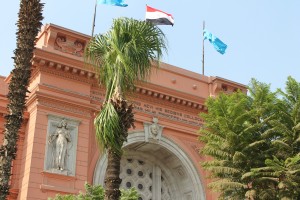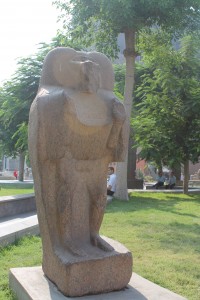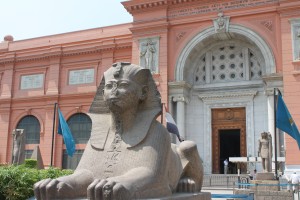I have always been intrigued by Ancient Egyptian History. I think even if I wasn’t Egyptian, I would still find it fascinating. In college I studied the subject, learning from a professor who, when he wasn’t teaching, was in Egypt conducting archaeological digs and helping to restore artifacts. He showed the most jaw-dropping slideshows each class.
Like I said, fascinating.
It’s also why whenever I travel to a place that has an Egyptian collection in their museum I go. I’ve been to the Metropolitan Museum of Art in New York, The Louvre in Paris and The British Museum in London. Always, I head straight to the Egyptian wing and take it in.
 This is why when a couple of years ago there was a King Tut display touring North America I was itching to go. I was thrilled when I made it to the exhibit in New York City, but disappointed when at the end I realized that King Tut? Well, he doesn’t travel with his belongings.
This is why when a couple of years ago there was a King Tut display touring North America I was itching to go. I was thrilled when I made it to the exhibit in New York City, but disappointed when at the end I realized that King Tut? Well, he doesn’t travel with his belongings.
Naturally when I came to Egypt the first time, I went to their museum. Unfortunately, after just a few minutes there, I got sick and asked my uncle to take me back to his place so I could sleep.
This time, I was ready. Despite the insane heat, I was determined to get through the mostly non-air-conditioned museum.
I am so glad I did.
I have never seen such an amazing collection of Egyptian artifacts. From the pillars that stood outside tombs, to the handcrafted  turquoise jewelry, to the carved statues of kings and queens, to the mummies and their cases…all of it was a sight to behold.
turquoise jewelry, to the carved statues of kings and queens, to the mummies and their cases…all of it was a sight to behold.
But nothing prepared me for what I saw next.
As my cousin and I casually strolled around the upstairs of the museum, pieces suddenly began to look familiar. Then it hit me. I recognized the golden chairs and alabaster canopic jars from pictures I had seen from King Tut’s tomb, from the moment Howard Carter discovered it in 1922.
There it was. All these majestic pieces sprawled out for me to stare at. And stare I did…and marvel…and wonder. I couldn’t believe what good condition the collection was in (Tutankhamun ruled around 1332 B.C). Each piece was more intricate and stunning than the one prior. (Sorry no cameras allowed in the museum!) And I realized that even though beautiful pieces had gone on tour, Egypt saved the best for their collection.
The pinnacle moment? Seeing the famous gold and black headdress that was placed over King Tut’s mummy.
It felt surreal to finally witness it all, after years of studying it and after years of imagining it.
What an experience. Thank you. I won’t forget it.
Much Gratitude,
A

